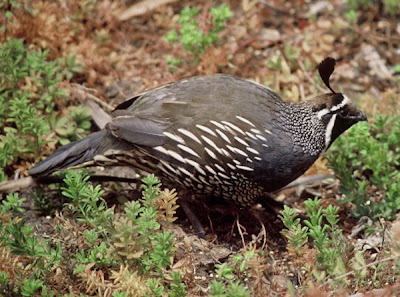Bird news
- A paper in Science may make our field guides obsolete. Genetic analysis by the Early Bird project of 169 bird species, representing all major groups, revealed that much of current bird taxonomy is wrong and that many bird groups that appear to be similar evolved separately. For example, falcons are more closely related to parrots and songbirds than to hawks and eagles. The most thorough account of the findings that I have seen so far is at Living the Scientific Life. Science Daily has a good write-up, too. National Geographic illustrates some of the new sister clades.
 Scientists at Manomet on Cape Cod analyzed data for 32 bird species and found that eight of them migrated past the observatory much earlier than they did 38 years ago. These eight are short-distance migrants coming from elsewhere in the U.S. and can adjust their migration schedules to keep up with earlier springs. Birds that winter in Central or South America have not adjusted as well because they do not have the same temperature cues.
Scientists at Manomet on Cape Cod analyzed data for 32 bird species and found that eight of them migrated past the observatory much earlier than they did 38 years ago. These eight are short-distance migrants coming from elsewhere in the U.S. and can adjust their migration schedules to keep up with earlier springs. Birds that winter in Central or South America have not adjusted as well because they do not have the same temperature cues.- A preliminary study in 2007 at Judith Gap Wind Energy Center found 1,206 bats and 406 birds died from turbine-related causes. The wind farm is the largest in Montana. ABC has a round-up of recent work on mitigation measures to prevent wind farm deaths.
- Agribusiness and ethanol lobbyists are pushing the federal government to allow farmers to plant corn on land that is currently in the Conservation Reserve Program. The CRP is the largest federal land conservation program and benefits many species of birds.
- White storks have benefited from a reintroduction program in Alsace and Lorraine. Twenty-five years ago, only 9 stork pairs were left in the Upper Rhine Valley; now there are 270 pairs.
- Eight captive California condors had to be evacuated from the Ventana Wildlife Society due to a nearby wildfire.
 The white-winged flufftail is an endangered species about which little is known, including whether it migrates. The lack of information frustrates conservation action plans.
The white-winged flufftail is an endangered species about which little is known, including whether it migrates. The lack of information frustrates conservation action plans.- The RSPB is working with hunting groups to reduce raptor killings on private lands.
- Illinois is re-evaluating its state list of threatened and endangered species.
- The Guardian has a gallery of the most aggressive birds.
- Another gallery shows a heron grabbing and eating a duckling.
- Here is a profile of the naturalist at Cheesequake State Park (New Jersey).
- The CLO has free resources available for teachers and parents who want to do citizen science projects in urban areas.
- Bug Girl: Aquatic Mercury in Food webs
- Picus Blog: Mississippi Kites in Newmarket, NH
- Rigor Vitae: English Sparrow Update (on predation by other birds)
- 10,000 Birds: Green Herons and their Groovy Necks
- Ecobirder: Yellowstone Barrow's Goldeneye
- Birdfreak: Bird Conservation - Prothonotary Warbler
- BES Group: White-throated Kingfisher: Non-iridescent colours
- Birds and Things: English Sparrows Seen As A Nuisance
- Zen Birdfeeder: Adirondack Loon Census July 19th (volunteers needed!)
- California has announced a plan to cut state greenhouse gas emissions to 1990 levels by 2020.
- Brazil seized 3,100 cattle that were grazing on illegally-cleared rainforest land.
- A sugar cane biofuels project in Kenya threatens to destroy the country's most diverse wetlands. The Tana Delta wetlands are home to 345 species of birds and support the livelihoods of thousands of farmers and fishermen.
- One result of Florida's purchase of U.S. Sugar lands is that it removes a political obstacle from Everglades restoration.
- A proposed coal-fired power plant in rural Virginia has drawn heavy opposition from residents.
- A study of the impact of acid rain on microorganisms in Adirondack lakes found that high acidity reduced overall bacterial diversity, but increased some rarer forms of bacteria.
- According to the Energy Information Administration, expanding offshore drilling would do little to change gasoline prices.
- James Hansen: Twenty Years Later




